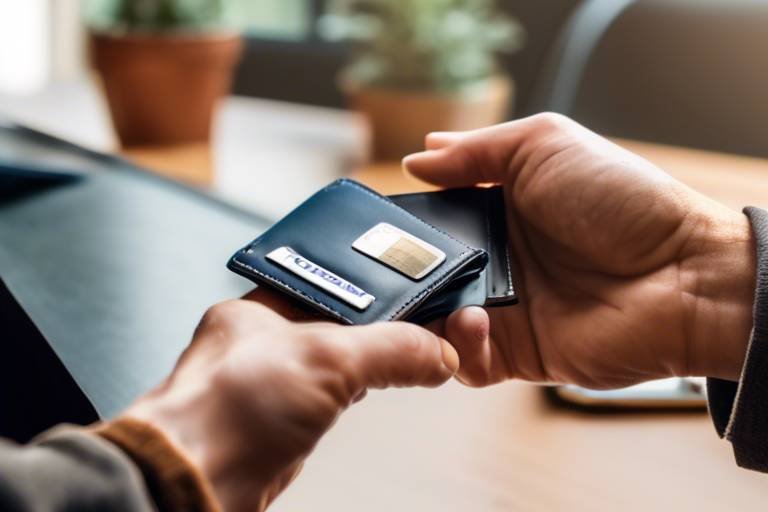How to Manage Your Crypto Portfolio Using Wallets and Exchanges
In the ever-evolving world of cryptocurrency, managing your digital assets effectively is not just a necessity; it's an art form. With thousands of cryptocurrencies available, knowing how to navigate through wallets and exchanges can make or break your investment journey. So, how do you ensure your portfolio is not only secure but also thriving? This article dives deep into the essential strategies for managing your crypto portfolio, emphasizing the roles of wallets and exchanges. Whether you’re a seasoned investor or just dipping your toes into the crypto waters, understanding these fundamental tools is key to unlocking your portfolio’s potential.
Crypto wallets are your digital treasure chests, safeguarding your precious cryptocurrencies. They come in various forms, each with its unique features and functionalities. At the core, wallets can be categorized into two main types: hot wallets and cold wallets. Hot wallets are connected to the internet, making them convenient for frequent trading, while cold wallets are offline, providing enhanced security for long-term storage.
Hot Wallets: These are user-friendly and perfect for active traders. They allow quick access to your assets, but they come with the risk of being exposed to online threats. Examples include mobile wallets and web-based wallets.
Cold Wallets: These are like a safe deposit box for your crypto. They keep your assets offline, away from hackers. Hardware wallets and paper wallets fall into this category. While they might require a bit more effort to access, the peace of mind they offer is priceless.
Choosing the right wallet depends on your trading style and security needs. Do you plan to trade frequently? A hot wallet may suit you best. If you're looking to hold your assets long-term, consider a cold wallet. Remember, the security of your investments starts with the right wallet choice.
Selecting a cryptocurrency exchange is akin to picking the right bank for your money. The exchange you choose can significantly impact your trading experience and portfolio management. When evaluating exchanges, consider factors such as security, fees, and available trading pairs. A user-friendly interface can also enhance your trading experience, making it easier to navigate through the complexities of cryptocurrency trading.
Security is paramount when trading cryptocurrencies. A compromised exchange can lead to significant losses. Therefore, it's crucial to understand the security measures that exchanges implement to protect your assets. Look for exchanges that offer robust security features, including:
- Two-Factor Authentication (2FA): This adds an extra layer of security by requiring a second form of verification, such as a code sent to your phone.
- Withdrawal Whitelists: This feature allows withdrawals only to pre-approved addresses, adding another layer of protection against unauthorized access.
- Cold Storage: Ensure the exchange keeps a significant portion of its assets in cold storage to protect them from online threats.
Two-factor authentication (2FA) is like having a double lock on your door. It requires not only your password but also a second piece of information, typically a code sent to your mobile device. This makes it significantly harder for hackers to gain access to your account. Always enable 2FA on your exchange accounts to safeguard your investments.
Withdrawal whitelists are a fantastic way to enhance your security. By allowing withdrawals only to pre-approved addresses, you can prevent unauthorized transactions. Setting up a withdrawal whitelist is straightforward; just navigate to your account settings on your exchange and add the addresses you trust. This simple step can save you from potential headaches down the line.
Implementing effective trading strategies is vital for portfolio growth. Whether you prefer day trading, swing trading, or long-term investing, having a clear strategy can help you navigate the volatile crypto market. Day trading involves making quick trades to capitalize on short-term price movements, while swing trading focuses on holding assets for several days or weeks to benefit from market swings. Long-term investing, on the other hand, is about holding onto your assets for an extended period, betting on their future value.
Diversifying your crypto portfolio is like spreading your bets in a casino; it can help mitigate risks. By allocating your investments across different cryptocurrencies, you reduce the impact of a poor-performing asset on your overall portfolio. This strategy not only protects your investments but also opens up opportunities for growth.
Consider allocating your assets based on market trends, technological advancements, and your risk tolerance. A well-diversified portfolio can provide a cushion against market volatility and enhance your chances of achieving your financial goals.
Understanding your risk tolerance is key to effective portfolio management. Are you a risk-taker or more conservative with your investments? Assessing your risk profile will guide your investment choices and help you create a portfolio that aligns with your comfort level. Remember, investing is not just about potential gains; it's also about how much risk you’re willing to take to achieve those gains.
Regularly rebalancing your portfolio ensures that your asset allocation aligns with your investment goals. As the market fluctuates, certain assets may grow at different rates, leading to an unbalanced portfolio. Establish a schedule for rebalancing, whether it’s quarterly or biannually, and stick to it. This practice helps you maintain your desired level of risk and ensures that you’re not overly exposed to any single asset.
1. What is a crypto wallet?
A crypto wallet is a digital tool that allows you to store, send, and receive cryptocurrencies safely.
2. How do I choose a cryptocurrency exchange?
Consider factors like security, fees, user experience, and the variety of cryptocurrencies offered when selecting an exchange.
3. What is portfolio diversification?
Portfolio diversification involves spreading your investments across various cryptocurrencies to reduce risk.
4. How often should I rebalance my portfolio?
It's generally recommended to rebalance your portfolio at least once every quarter or biannually.

Understanding Crypto Wallets
When diving into the world of cryptocurrency, one of the first things you’ll encounter is the concept of crypto wallets. These wallets are not physical items like your traditional wallet; instead, they are digital tools that allow you to store, send, and receive cryptocurrencies securely. Think of them as your personal bank account in the digital realm, tailored specifically for managing your virtual assets. But not all wallets are created equal, and understanding the different types available is crucial for effective portfolio management.
There are primarily three types of crypto wallets: hot wallets, cold wallets, and hardware wallets. Each type has its own unique features and benefits, catering to different needs and preferences. Let’s break them down:
- Hot Wallets: These wallets are connected to the internet, making them incredibly convenient for quick transactions. They are ideal for active traders who need immediate access to their funds. However, because they are online, they come with a higher risk of hacks and security breaches.
- Cold Wallets: In contrast, cold wallets are offline storage solutions, which makes them significantly more secure. They are perfect for long-term investors who want to hold their assets without the worry of online threats. However, accessing your funds can be less convenient since you need to connect to the internet to make transactions.
- Hardware Wallets: A hybrid between hot and cold wallets, hardware wallets are physical devices that store your cryptocurrency offline but can be connected to the internet when needed. They offer robust security features and are highly recommended for serious investors looking to protect their assets.
Choosing the right wallet depends on your individual needs. If you’re a frequent trader, you might lean towards a hot wallet for its accessibility. On the other hand, if you’re in it for the long haul, a cold wallet or hardware wallet might be more suitable to keep your investments safe from prying eyes.
Aside from the type of wallet, it’s essential to consider the security features that each wallet offers. Look for wallets that support features like two-factor authentication, backup options, and encryption. These measures can significantly enhance the security of your digital assets. Remember, in the world of cryptocurrencies, your security is paramount. The more secure your wallet, the less likely you are to fall victim to theft or fraud.
In conclusion, understanding crypto wallets is a fundamental step in managing your cryptocurrency portfolio effectively. By knowing the differences between hot, cold, and hardware wallets, you can make informed decisions that align with your trading habits and security needs. Always remember to conduct thorough research before choosing a wallet, as the safety of your investments depends on it!

Choosing the Right Exchange
When diving into the world of cryptocurrency, one of the most crucial decisions you'll make is selecting the right exchange. Think of it as choosing the right bank for your money; you wouldn’t just pick any random institution, would you? The exchange you choose can significantly impact your trading experience, security, and overall portfolio performance. So, what should you look for in an exchange? Let’s break it down.
First and foremost, security is non-negotiable. You want to ensure that your assets are protected from hackers and other threats. Look for exchanges that offer robust security features, such as two-factor authentication (2FA), withdrawal whitelists, and cold storage for the majority of their assets. After all, what good is your investment if you can't sleep at night knowing it's safe?
Next on the list is fees. Different exchanges have different fee structures, which can eat into your profits if you're not careful. Some may charge a flat fee per transaction, while others might take a percentage of your trades. It's essential to read the fine print and understand what you're getting into. You wouldn't want to be blindsided by hidden fees when you're trying to make a profit!
Another factor to consider is the available trading pairs. Not all exchanges support the same cryptocurrencies, and if you're looking to diversify your portfolio, you'll want to choose an exchange that offers a wide range of trading options. Imagine trying to find a rare collectible, only to discover it’s not available at your chosen marketplace. Frustrating, right?
Lastly, take a moment to evaluate the user experience. A user-friendly interface can make a world of difference, especially for beginners. The last thing you want is to feel overwhelmed by a complicated platform when you're trying to buy or sell your assets. Look for exchanges that offer intuitive designs and helpful resources, such as tutorials and customer support.
To summarize, when choosing the right exchange, keep these key factors in mind:
- Security: Look for features like 2FA and cold storage.
- Fees: Understand the fee structure to avoid surprises.
- Available Trading Pairs: Ensure the exchange supports the cryptocurrencies you want to trade.
- User Experience: Choose a platform that is easy to navigate.
By carefully considering these factors, you can make an informed decision that aligns with your trading goals. Remember, the right exchange can be a game-changer in your crypto journey, so take your time and do your research!

Security Features of Exchanges
When it comes to trading cryptocurrencies, security should be your top priority. The world of digital assets is exciting and full of potential, but it also comes with its fair share of risks. So, how can you ensure that your hard-earned investments are safe? One of the best ways is to choose an exchange that prioritizes security. Let’s dive into some of the key security features that reputable exchanges implement to protect users and their assets.
First and foremost, most exchanges use encryption technology to secure data transmission between users and the exchange. This means that your personal information and transaction details are encrypted, making it much harder for hackers to intercept and misuse them. Additionally, many exchanges employ cold storage for the majority of their digital assets. Cold storage refers to keeping cryptocurrencies offline, away from the internet, which significantly reduces the risk of hacking.
Another crucial aspect of exchange security is the implementation of two-factor authentication (2FA). This feature adds an extra layer of protection by requiring users to verify their identity through a second method, typically a mobile app or SMS code, in addition to their password. Imagine locking your front door and then adding a second lock—this is what 2FA does for your exchange account. It’s a simple step that can make a world of difference in keeping your assets safe.
Furthermore, many exchanges offer withdrawal whitelists. This feature allows users to specify certain addresses to which withdrawals can be made. If a hacker gains access to your account, they won’t be able to withdraw funds to an address that hasn't been pre-approved by you. Setting up a withdrawal whitelist is straightforward and can be a game-changer in securing your investments.
In addition to these features, exchanges often conduct regular security audits and employ insurance policies to cover potential losses due to breaches. This means that if something goes wrong, you might be able to recover some or all of your funds, depending on the exchange's policy. Always check whether the exchange you’re considering has such measures in place.
To summarize, here are some key security features you should look for when choosing a cryptocurrency exchange:
- Encryption technology for secure data transmission
- Cold storage of digital assets
- Two-factor authentication (2FA) for an extra layer of security
- Withdrawal whitelists to control withdrawal addresses
- Regular security audits and insurance policies for added protection
By understanding and utilizing these security features, you can significantly enhance the safety of your cryptocurrency investments. Remember, in the fast-paced world of digital currencies, staying informed and proactive about security can mean the difference between success and loss.

Two-Factor Authentication
When it comes to safeguarding your cryptocurrency investments, two-factor authentication (2FA) is like having a fortified castle around your digital assets. Imagine you have a key to your house, but you also need a secret code to enter. That's essentially what 2FA does for your exchange account. It adds an extra layer of security that makes it significantly harder for unauthorized users to gain access, even if they somehow manage to obtain your password.
So, how does 2FA work? Well, once you enable it on your exchange account, you will be required to provide two forms of identification before you can log in or make transactions. The first is typically your password, which you already know. The second is a code generated by a mobile app, such as Google Authenticator or Authy, or sent to you via SMS. This code changes every 30 seconds, making it nearly impossible for hackers to use stolen credentials.
To get started with 2FA, follow these simple steps:
- Download a 2FA app on your smartphone.
- Link the app to your exchange account by scanning a QR code provided by the exchange.
- Store backup codes in a secure location, in case you lose access to your 2FA app.
- Always log in using both your password and the current 2FA code.
Enabling 2FA can significantly reduce the risk of your account being compromised. However, it’s essential to remember that no security measure is foolproof. Always remain vigilant and keep your software updated. Just like a knight must always be on guard, you too should stay alert for any suspicious activity in your account.
Now, you might be wondering, what happens if you lose your phone or can't access your 2FA app? This is where having those backup codes comes in handy. They act as a safety net, allowing you to regain access to your account without the 2FA code. Always keep these codes in a secure place, like a password manager or a physical safe.
In summary, is not just an optional feature; it’s a crucial step in protecting your crypto portfolio. By implementing 2FA, you're taking proactive measures to ensure that your investments remain secure, allowing you to focus on what really matters: growing your portfolio and navigating the exciting world of cryptocurrency.
- What is two-factor authentication?
Two-factor authentication (2FA) is a security process that requires two different forms of identification to access an account, enhancing security. - How do I set up 2FA?
You can set up 2FA by downloading a 2FA app, linking it to your account, and following the instructions provided by your exchange. - What should I do if I lose my phone?
If you lose your phone, use the backup codes you saved during the setup process to regain access to your account. - Is 2FA foolproof?
While 2FA significantly enhances security, it is not entirely foolproof. Staying vigilant and monitoring your account activity is essential.

Withdrawal Whitelists
When it comes to securing your cryptocurrency investments, are a game changer. Imagine having a safety net that only allows withdrawals to specific, pre-approved addresses. This feature acts like a bouncer at a club, ensuring that only those you trust can take your assets out of the exchange. By setting up a withdrawal whitelist, you significantly reduce the risk of unauthorized transactions, which is especially crucial in the fast-paced world of crypto.
So, how does this work? Essentially, when you enable a withdrawal whitelist, you must register the addresses to which you want to allow withdrawals. Any attempt to withdraw funds to an address not on the whitelist will be blocked, giving you peace of mind. But remember, it's vital to keep this list updated. If you change wallets or decide to use a different one, you'll need to add the new address to your whitelist before making any transactions.
To set up a withdrawal whitelist, follow these general steps:
- Log into your cryptocurrency exchange account.
- Navigate to the security settings or withdrawal settings section.
- Locate the option for withdrawal whitelists.
- Add the addresses you want to whitelist.
- Save your changes and confirm any necessary security prompts.
It's also worth noting that different exchanges have varying procedures for implementing whitelists. Some may require you to verify your identity or provide additional authentication before allowing changes to the whitelist. Always check the specific guidelines of your exchange to ensure you're following the correct process.
In summary, withdrawal whitelists are a simple yet effective way to enhance the security of your crypto portfolio. By limiting withdrawals to approved addresses, you can protect your assets from potential hacks and unauthorized access. Just remember to keep your whitelist updated and maintain a record of your approved addresses to avoid any hiccups when you need to access your funds.

Trading Strategies for Your Portfolio
When it comes to managing your cryptocurrency portfolio, employing effective trading strategies can be the difference between a thriving investment and a disappointing one. Think of trading strategies as the roadmap to your financial journey in the crypto world. Without a clear direction, you might find yourself lost in the vast sea of digital currencies. So, what are the most popular strategies that can help you navigate this exciting landscape? Let's dive into some of the key approaches!
First up, we have day trading. This strategy involves making multiple trades within a single day, capitalizing on short-term price movements. It’s like surfing the waves; you need to catch the right one at the right time. Day traders often rely on technical analysis and charts to identify trends and make quick decisions. However, this method requires a significant time commitment and a solid understanding of market dynamics. If you’re the type who enjoys fast-paced environments and can handle the pressure, day trading might be your cup of tea.
Next, let’s talk about swing trading. Unlike day trading, swing trading involves holding onto your assets for several days or weeks to benefit from price swings. This strategy is akin to fishing; you cast your line and wait patiently for the right catch. Swing traders analyze market trends and patterns to predict future movements, allowing them to enter and exit trades at the most opportune times. This approach may be less hectic than day trading, making it more suitable for those who prefer a more laid-back yet strategic investment style.
Then, we have the classic approach of long-term investing. This strategy is all about patience and vision. Think of it as planting a tree; you nurture it over time, and eventually, it bears fruit. Long-term investors typically buy and hold cryptocurrencies for months or even years, banking on their potential growth over time. This strategy is less affected by short-term market volatility and allows you to ride out the market's ups and downs. If you believe in the long-term potential of certain cryptocurrencies, this could be the strategy for you.
Now, let’s not forget about the importance of diversification in your trading strategy. Just like you wouldn’t put all your eggs in one basket, spreading your investments across various cryptocurrencies can help mitigate risks. By diversifying, you’re less likely to suffer significant losses if one asset takes a downturn. Consider allocating your portfolio as follows:
| Cryptocurrency | Percentage of Portfolio |
|---|---|
| Bitcoin | 40% |
| Ethereum | 30% |
| Altcoins | 20% |
| Stablecoins | 10% |
This sample allocation shows how you can spread your investments across major cryptocurrencies while still having a safety net with stablecoins. Remember, the key to successful trading is not just about picking the right coins but also about managing your overall risk effectively.
In conclusion, whether you choose day trading, swing trading, or long-term investing, it’s essential to develop a strategy that aligns with your financial goals and risk tolerance. Always stay informed about market trends, continuously educate yourself, and don’t hesitate to adjust your strategies as needed. The world of cryptocurrency is ever-evolving, and being adaptable can lead to greater success in managing your portfolio.
- What is the best trading strategy for beginners? For beginners, long-term investing is often recommended as it requires less time and is less stressful.
- How much time do I need to dedicate to day trading? Day trading requires significant time, often several hours a day, to monitor the market closely.
- Is diversification really necessary? Yes, diversification helps reduce risk and can lead to more stable returns over time.

Portfolio Diversification
Diversifying your crypto portfolio is not just a good idea; it's a critical strategy for mitigating risks and enhancing potential returns. Think of your investment portfolio like a fruit basket. If you fill it with only one type of fruit, say apples, and a sudden frost hits, you could lose everything. But if you mix in bananas, oranges, and grapes, the frost might affect the apples, but you still have other fruits to enjoy. Similarly, by diversifying your cryptocurrency investments, you can protect yourself from the volatility that often plagues the crypto market.
So, what does diversification look like in the world of cryptocurrency? It involves spreading your investments across various digital assets rather than concentrating them in a single coin. This approach can help to balance out the highs and lows of the market, as not all cryptocurrencies will react the same way to market changes. For example, while Bitcoin might soar, Ethereum could experience a dip. By holding both, you can cushion the impact of losses.
When it comes to allocating your assets, consider the following strategies:
- Market Cap Segmentation: Invest in a mix of large-cap, mid-cap, and small-cap cryptocurrencies. Large-cap coins like Bitcoin and Ethereum tend to be more stable, while smaller coins can offer higher growth potential.
- Sector Diversification: Look at different sectors within the crypto space, such as DeFi (Decentralized Finance), NFTs (Non-Fungible Tokens), and stablecoins. Each sector has its unique dynamics and can respond differently to market trends.
- Geographical Spread: Consider investing in cryptocurrencies that are popular in different regions. This can help you tap into emerging markets and reduce the impact of localized economic issues.
However, while diversification is essential, it's equally important to maintain a focused approach. Over-diversification can lead to diminished returns and make it harder to manage your portfolio effectively. A well-balanced portfolio might contain anywhere from 5 to 15 different cryptocurrencies, depending on your investment goals and risk tolerance.
Moreover, regular portfolio reviews are crucial. The crypto market is dynamic, and what works today might not work tomorrow. By keeping an eye on your investments and adjusting your allocations as needed, you can ensure that your portfolio remains aligned with your financial objectives. This might mean selling off some assets that are underperforming or reallocating funds to new opportunities that arise.
In summary, effective diversification in your crypto portfolio can significantly reduce risk and enhance potential returns. By spreading your investments across different cryptocurrencies and sectors, you can better navigate the turbulent waters of the crypto market. Remember, it’s not just about how much you invest, but how wisely you distribute your investments!
Q: What is portfolio diversification?
A: Portfolio diversification is the strategy of spreading investments across various assets to reduce risk and improve potential returns.
Q: How many cryptocurrencies should I hold in my portfolio?
A: A balanced portfolio typically contains between 5 to 15 different cryptocurrencies, depending on your risk tolerance and investment goals.
Q: Why is diversification important in cryptocurrency?
A: Diversification helps mitigate risks associated with the volatility of the crypto market, ensuring that losses in one asset can be offset by gains in another.

Assessing Risk Tolerance
When it comes to managing your crypto portfolio, one of the most crucial steps is assessing your risk tolerance. But what exactly does that mean? In simple terms, risk tolerance refers to your ability and willingness to endure fluctuations in the value of your investments. Think of it as your financial comfort zone. Are you someone who can sleep soundly at night even if the market takes a nosedive, or do you find yourself stressing over every little dip? Understanding where you stand on this spectrum is essential for making informed investment decisions.
To get a clearer picture of your risk tolerance, consider a few key factors:
- Investment Goals: Are you looking for short-term gains, or are you in it for the long haul? Your objectives will greatly influence how much risk you can take on.
- Time Horizon: How long do you plan to hold your investments? If you’re looking at a longer time frame, you might be more comfortable with higher risk since you have time to recover from potential losses.
- Financial Situation: Your current financial standing plays a significant role. If you have a stable income and savings, you might be more willing to take risks compared to someone who is living paycheck to paycheck.
Another effective way to assess your risk tolerance is through a simple questionnaire. Many financial advisors offer these tools, but you can create your own by asking yourself questions such as:
- How would you react if your investment dropped by 20%?
- What percentage of your portfolio are you willing to lose in a worst-case scenario?
- Do you prefer to play it safe with stable investments, or are you open to high-volatility options?
Once you've reflected on these aspects, you'll have a better understanding of where you fit on the risk spectrum. Keep in mind that risk tolerance is not static; it can change over time due to life circumstances, market conditions, or shifts in your financial goals. Regularly revisiting your risk profile is a smart strategy to ensure that your investment approach aligns with your current situation.
In conclusion, assessing your risk tolerance is not just a one-time task; it’s an ongoing process that requires introspection and adaptability. By understanding your comfort level with risk, you can make more informed decisions, tailor your investment strategies, and ultimately enhance the management of your crypto portfolio.
What is risk tolerance in cryptocurrency investing?
Risk tolerance refers to the degree of variability in investment returns that an individual is willing to withstand. It helps determine how much risk you can take on with your investments.
How can I assess my risk tolerance?
You can assess your risk tolerance by considering factors like your investment goals, time horizon, and financial situation. Additionally, answering specific questions about your reactions to market fluctuations can help clarify your comfort level.
Does risk tolerance change over time?
Yes, risk tolerance can change due to various factors such as life events, changes in financial status, or shifts in market conditions. It’s important to regularly evaluate your risk profile.
Can I adjust my portfolio based on my risk tolerance?
Absolutely! Understanding your risk tolerance allows you to tailor your investment strategies and diversify your portfolio in a way that aligns with your comfort level.

Rebalancing Your Portfolio
Rebalancing your portfolio is like tending to a garden; just as you need to prune and nurture your plants to keep them healthy, you must regularly adjust your investments to ensure they align with your financial goals. Over time, certain assets may outperform others, leading to an imbalance in your portfolio. This imbalance can expose you to unnecessary risks or prevent you from achieving your desired returns. So, how do you go about rebalancing effectively?
First, it's essential to establish a clear understanding of your investment goals and risk tolerance. Are you aiming for aggressive growth, or are you more conservative in your approach? Knowing this will help you determine the ideal asset allocation. For example, if your goal is to achieve a balanced portfolio, you might want to maintain a mix of various cryptocurrencies, such as Bitcoin, Ethereum, and some altcoins. This way, if one asset dips, others might compensate for the loss.
Next, consider setting specific intervals for rebalancing. Many investors choose to review their portfolios on a quarterly or annual basis. However, you might also opt for a more dynamic approach, rebalancing whenever your asset allocation deviates significantly from your target percentages. For instance, if Bitcoin rises to account for 70% of your portfolio while your target allocation is only 50%, it’s time to sell some Bitcoin and reinvest in other assets.
Moreover, it’s crucial to avoid emotional decision-making during this process. The crypto market can be highly volatile, and it’s easy to get swept up in the excitement or panic of price swings. Instead of making impulsive decisions, stick to your rebalancing strategy and trust the process. Think of it as a road trip: you wouldn’t change your destination just because you hit a few bumps along the way, right?
When rebalancing, consider the tax implications of your trades. Selling assets that have appreciated significantly can lead to capital gains taxes. To minimize this impact, you might choose to rebalance by using new funds for investment rather than selling existing assets. This strategy not only helps you maintain your desired allocation but also keeps your tax bill in check.
Finally, keep an eye on market trends and developments. The cryptocurrency landscape is ever-evolving, and new projects or regulatory changes can impact your investment strategy. Staying informed will help you make educated decisions about when and how to rebalance your portfolio.
In summary, rebalancing your crypto portfolio is a vital practice that can enhance your investment strategy and help you stay on course toward your financial goals. By establishing a clear plan, avoiding emotional decisions, and remaining informed about market dynamics, you can ensure your portfolio remains healthy and aligned with your investment objectives.
- How often should I rebalance my crypto portfolio? It depends on your investment strategy, but many investors choose to rebalance quarterly or annually.
- What should I consider when rebalancing? Consider your investment goals, risk tolerance, and the tax implications of selling assets.
- Can I rebalance without selling assets? Yes, you can use new funds to invest in underrepresented assets instead of selling existing ones.
- What if the market is highly volatile? Stick to your rebalancing strategy and avoid making impulsive decisions based on market fluctuations.
Frequently Asked Questions
- What is a crypto wallet and why do I need one?
A crypto wallet is like your digital bank account, but instead of holding cash, it stores your cryptocurrencies securely. You need one to manage, send, and receive your digital assets safely. Without a wallet, your crypto may be vulnerable to theft or loss.
- How do I choose the right cryptocurrency exchange?
Choosing the right exchange is crucial for your investment journey. Look for factors like security features, user reviews, fees, and the variety of cryptocurrencies available for trading. Think of it like picking a restaurant; you want one that's reliable and has a menu that suits your taste!
- What security measures should I look for in an exchange?
Security is paramount in the crypto world. Look for exchanges that offer two-factor authentication (2FA), withdrawal whitelists, and cold storage options. These features act like a security alarm for your investments, keeping them safe from potential threats.
- What is two-factor authentication (2FA) and how does it work?
Two-factor authentication (2FA) adds an extra layer of protection to your account by requiring two forms of verification before you can access it. Think of it as needing both a key and a password to unlock your front door; it makes it much harder for intruders to get in!
- Why is portfolio diversification important?
Diversification is like not putting all your eggs in one basket. By spreading your investments across different cryptocurrencies, you reduce the risk of losing everything if one asset performs poorly. It’s a smart strategy to help stabilize your portfolio.
- How often should I rebalance my crypto portfolio?
Rebalancing your portfolio is essential to keep your asset allocation in line with your investment goals. A good rule of thumb is to review your portfolio at least once every few months or whenever there are significant market changes. It's like tuning a musical instrument; regular adjustments keep everything in harmony!
- What are some popular trading strategies for cryptocurrency?
Popular trading strategies include day trading, swing trading, and long-term investing. Each comes with its own risk levels and time commitments. Think of it like different sports; some require quick reflexes and constant action, while others are more about strategy and patience.
- How can I assess my risk tolerance?
Assessing your risk tolerance involves evaluating how much risk you’re comfortable taking with your investments. Consider factors like your financial situation, investment goals, and emotional response to market fluctuations. It’s like figuring out how fast you want to drive; some prefer the thrill of speed, while others prefer a more cautious approach.



















